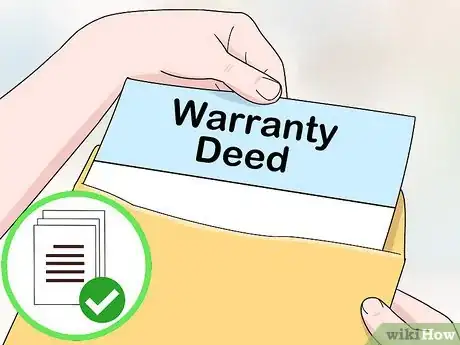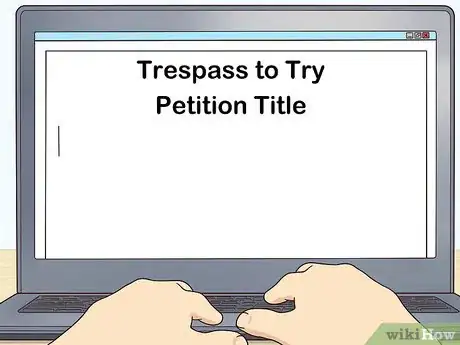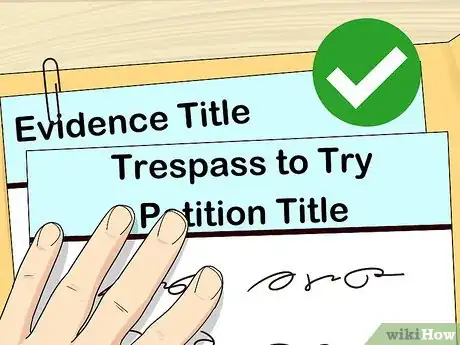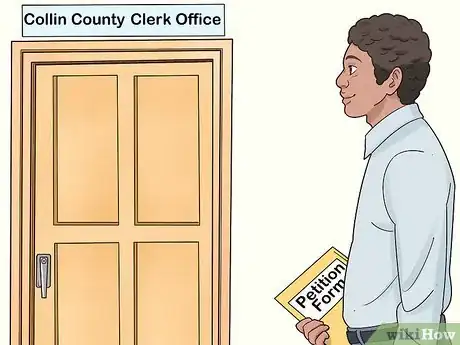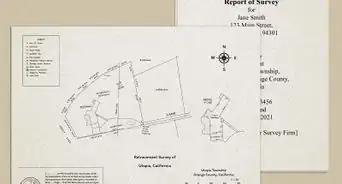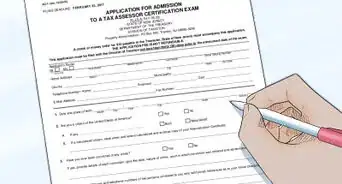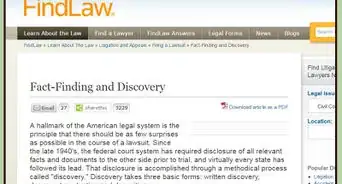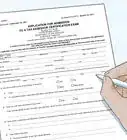This article was written by Jennifer Mueller, JD. Jennifer Mueller is an in-house legal expert at wikiHow. Jennifer reviews, fact-checks, and evaluates wikiHow's legal content to ensure thoroughness and accuracy. She received her JD from Indiana University Maurer School of Law in 2006.
There are 7 references cited in this article, which can be found at the bottom of the page.
This article has been viewed 64,623 times.
Under the theory of adverse possession, you can claim ownership of property that belongs to someone else. Under Texas law, your possession of the property must be exclusive, open, continuous, and without the permission of the property owner for 3-10 years, depending on the circumstances.[1] The property owner has 25 years in which to challenge your claim. You can file for adverse possession in Texas by filing a lawsuit in county court. Successful adverse possession claims are rare, and the evidentiary requirements are substantial, because adverse possession involves a court taking someone's property and giving it to someone else.[2]
Steps
Meeting Adverse Possession Requirements
-
1Gather legal documents related to the property. To succeed in an adverse possession claim, your possession of the property must be uninterrupted. If at any time the owner of record made any attempt to reclaim the property (in the form of a lawsuit, a letter asking you to leave, or a police report for trespassing), the period of time you adversely possessed the property would start over.[3]
- Texas adverse possession law greatly favors the record owner. The more documents and proof you have that the record owner has abandoned the property, the greater your chances of succeeding in your claim.
- Any documents filed in the county recorder's office that are related to the property also might be considered to interrupt your claim. For example, a tax lien filed on the property for nonpayment of property taxes would interrupt your claim.
-
2Fence the property. A fence is a basic way to openly indicate your intent to claim the property and exclude others from it. However, under Texas law, it can't just be any kind of fence. The fence must enclose the property to which you claim adverse possession.[4]
- The fence can't be one that doesn't follow the borders of the property. To the extent that it doesn't, you can't lay claim to any property outside the fence. If you only fence off part of the property, you only have a claim, at most, to the part you've fenced.
- Texas law also doesn't allow "casual fences" to establish adverse possession.[5] These are fences put up to keep out livestock, or for decorative purposes. Fences erected for an unknown purpose before you took possession of the land may also be considered “casual fences.” Use a tall privacy fence that is clearly designed to enclose the property and keep other people out.
Advertisement -
3Pay taxes on the property. If you pay taxes on the property, this is an unmistakable sign that you intend to take over the property and claim it as your own. It can also shorten the length of time the property owner of record has to dispute your claim to 5 years.[6]
- If the record owner of the property is paying property taxes, you have no claim of adverse possession. Your possession of the property would not be considered exclusive or uninterrupted, since the owner is paying property taxes.
- Paying property taxes is no guarantee. If you pay the property taxes and later lose your adverse possession claim, you may not be able to get that money back.
- On the other hand, if you don't pay the property taxes and no one else is, you run the risk that the property will be subject to a tax lien.
-
4Make improvements to the property. If you improve the property, such as by cultivating the land or building a house on it, you also shorten the length of time the record owner has to dispute your claim.[7]
- If you file a deed and pay taxes on the property, the property owner of record only has 5 years to file a lawsuit against you disputing your claim to the property.
- More commonly, adverse possessors improve the property without filing a deed. This shortens the period of time from 25 years to 10.[8]
-
5Create a new chain of title. Texas law requires adverse possessors to have title or "color of title." This comes in the form of a deed filed with the county recorder's office that includes language indicating you are adversely possessing the property.[9]
- The deed you file must be a warranty deed, not a quitclaim deed. If you decide you want to create a new chain of title, talk to a real estate attorney who has experience doing this. The language used in your deed must be very specific.
-
6Evaluate the applicable requirement of possession period. The default period of time for which you must continually possess the property in good faith is 10 years, but you can shorten it in various ways.[10] In general, the landowner has 25 years in which to challenge your claim to the property, after which the title passes to you.
- The shortest period is 3 years. For this period to apply, you must have filed a warranty deed to the property in the county recorder's office.
- The owner of record has 5 years to dispute your claim if you file a deed, make improvements, and pay property taxes.
- If you make improvements but don't file a deed, you must occupy the property for 10 years, and the owner has 25 years in which to challenge your claim.
Filing a Lawsuit for Adverse Possession
-
1Consult a real estate attorney. Adverse possession is a complex area of property law, and successful cases of adverse possession are rare. If you intend to file a suit for adverse possession, it's best to have an experienced attorney on your side.[11]
- Ideally, you want an attorney who has experience representing adverse possessors in trespass to try title lawsuits.
- If you decide to go it alone, the court will expect you to know and follow Texas law, including rules of evidence and procedure, just as an attorney would. The requirements for this type of lawsuit are complicated and time-consuming.
-
2Locate the owner of record. When you file your lawsuit, you must include the full legal name of the owner of record on the lawsuit. You also need to be able to serve them with the lawsuit in some way, which means you need at least a general location if not a specific address.
- This information may be included in the deeds filed for the property at the county recorder's office. However, it's also likely the deed would simply include the address of the property you currently possess and use.
- Property tax records might also provide some clues as to the owner of record's location.
-
3Draft a "trespass to try title" petition. This petition must include specific facts about your claim or the court will dismiss it. These facts are listed in Rule 783 of the Texas Rules of Civil Procedure. You must demonstrate that you have had possession of the property in good faith for at least 1 year before the date of action, and that you have made permanent and valuable improvements to the property during your period of possession.[12]
- At a minimum, your petition must include a specific legal description of the property, along with a description of your interest in or title to the property. These petitions have extensive legal requirements, so get help from an experienced property law attorney.
- Typically, these lawsuits are filed by the owner of record against a trespasser or adverse possessor. However, you can also file this lawsuit to gain record title of the property.[13]
- You will need to provide grounds for your claim, as well as a list of any improvements you have made and the value of those improvements.[14]
-
4Attach evidence of title. Your petition rests on the claim that you have a superior title to ownership of the property. If you filed a deed to create a new chain of title, a copy of that deed should be attached to your petition.[15]
- If you don't have any title or deed to the property, your complaint must include specific language that describes your right to the property under the theory of adverse possession. In this situation, you would need evidence that the record owner had notice of your possession and did not dispute it during the statutory period. The law here is complex, so get an attorney to help you if this is your situation.
-
5Take your petition to the proper clerk's office. File your lawsuit with the clerk of the court in the county where the property is located. Call ahead or check the court's website to find out if any additional forms are required, as well as the amount of the filing fees and methods of payment accepted.[16]
- Bring your original petition as well as 2 copies. The clerk will stamp them all and give the 2 copies back to you. One copy is for your own records, while the other is for the owner of record.
-
6Have the record owner served. If you know the location of the record owner, service is a fairly simple process. Hire a sheriff's deputy or private process server to hand-deliver the petition along with a subpoena to the record owner.
- If you don't have an exact address where the owner of record can be found, you can serve them through publication. This means you publish a legal advertisement announcing the petition in a newspaper of record in the area or areas where the owner might be. Typically publishing in the county where the property is located is sufficient.
- If you don't have an attorney and need to serve the owner through publication, someone in the clerk of court's office can help you determine where, when, and how to publish your advertisements.
-
7Gather evidence of your adverse possession. One of the reasons adverse possession claims are rarely successful is the difficulty of finding sufficient evidence to prove the claim. In addition to legal documents, you need photos and testimony from witnesses, including neighbors and friends.[17]
- Since your possession must be continuous, your evidence must also be continuous. This means if, for example, your claim falls under the 10-year statute of limitations period, you need evidence that you continuously, exclusively, and openly possessed and used the property for 10 years.
- For possession to be continuous, it must be regular and habitual, not sporadic or occasional. Your possession must also be exclusive, meaning no one else had access to the property. A proper fence typically may establish this. Finally, you must show that your possession was open, which means the record owner and anyone in the area saw that you were possessing or using the property.
-
8Appear in court for the hearing. You will have a hearing before a judge, who will review the petition and facts presented. If the record owner has been served and they don't show up or respond to your lawsuit, you may be eligible to win by default.[18]
- In court, it is up to you to prove that you have superior title to the property and the land is rightfully yours. The judge decides who has rightful title to the property based on the evidence presented.
- If you do not prove that you have superior title, the judge will issue a "take nothing" order, which divests you of any and all interest you ever had in the property. If you made improvements to the property, you may be able to make a claim to be compensated for those. You can request compensation at the hearing.
References
- ↑ http://statelaws.findlaw.com/texas-law/texas-adverse-possession-laws.html
- ↑ http://www.lonestarlandlaw.com/Adverse.html
- ↑ http://www.statutes.legis.state.tx.us/Docs/SDocs/CIVILPRACTICEANDREMEDIESCODE.pdf
- ↑ https://assets.recenter.tamu.edu/documents/articles/1776.pdf
- ↑ http://caselaw.findlaw.com/tx-court-of-appeals/1348922.html
- ↑ http://www.lonestarlandlaw.com/Adverse.html
- ↑ http://www.statutes.legis.state.tx.us/Docs/SDocs/CIVILPRACTICEANDREMEDIESCODE.pdf
- ↑ https://assets.recenter.tamu.edu/documents/articles/1776.pdf
- ↑ https://assets.recenter.tamu.edu/documents/articles/1776.pdf
- ↑ https://assets.recenter.tamu.edu/documents/articles/1776.pdf
- ↑ https://www.baylor.edu/doc.php/246017.pdf
- ↑ http://www.statutes.legis.state.tx.us/Docs/PR/htm/PR.22.htm
- ↑ https://assets.recenter.tamu.edu/documents/articles/1776.pdf
- ↑ http://www.statutes.legis.state.tx.us/Docs/PR/htm/PR.22.htm
- ↑ https://www.baylor.edu/doc.php/246017.pdf
- ↑ http://www.statutes.legis.state.tx.us/Docs/SDocs/CIVILPRACTICEANDREMEDIESCODE.pdf
- ↑ https://www.baylor.edu/doc.php/246017.pdf
- ↑ https://www.baylor.edu/doc.php/246017.pdf
About This Article
In certain cases, under the theory of Adverse Possession in Texas, you may be able to claim ownership of property that belongs to someone else. While successful claims are rare, there are a few instances where you could be granted ownership. For instance, if you’ve paid taxes on the property, have fully fenced it in, or have made significant improvements to it, these all signify your intent to assume the property as your own. If you have done any of these things and possessed the property for 10 years, you may have grounds for adverse possession. You’ll then need to hire a real estate attorney, locate the owner of record of the property, and have them served. Then, you’ll need to appear in a hearing where you and your lawyer will present evidence as to why the property should be yours. To learn how to shorten the 10-year requirement of possession period, read more from our Legal co-author!




